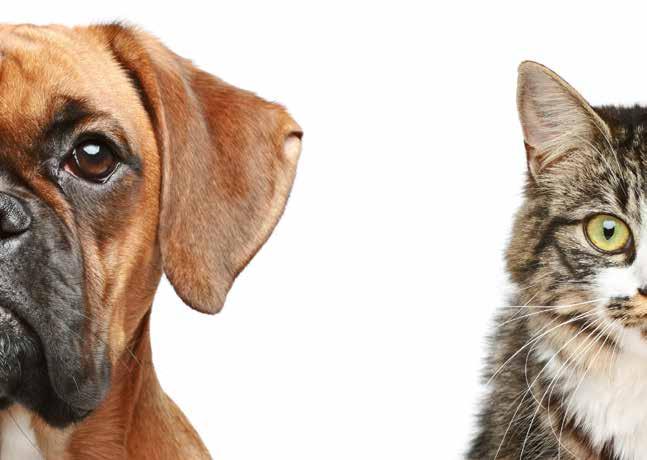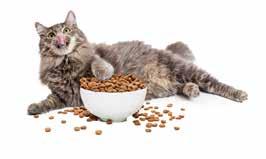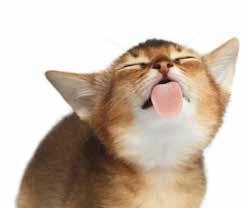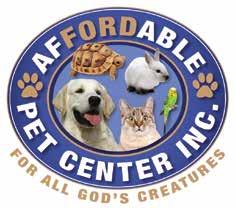




















Bucky Barnes came into our lives when we least expected it. He completed our Marvel dog trio and has a brother named Tony Stark and a sister named Pepper Potts. Bucky resembled a stuffed toy as a puppy, just look at those eyes! He is eight months old now and loves playing with other dogs, going to training, watching his human boy play baseball, stealing socks, and biting toes! He is such a laid back pup, we always say that he is an old dog born into a puppy body. You can see more of Bucky and his pals on Instagram @Smushyfaceposse.
Office Location:
255E S. Best Ave. (Rt. 145) Walnutport, PA 18088
Phone: 610-923-0382 • Fax: 610-923-0383
E-mail: AskUs@HomeNewsPA.com
Paul & Lisa Prass - Publishers

Catherine Stroh - Associate Publisher & Editor
Tony Pisco - Art Director
David Farkas and Robin Dengler - Delivery Drivers
pawlicy.com
There’s no way to anticipate what will happen in the future — you can’t predict when or how your pets will get sick, or how much it will cost. Pet insurance protects against unexpected veterinary bills.
As most Americans struggle to afford a $1,500 emergency vet bill, and one out of every three pets will require emergency treatment each year, the right pet insurance can be a lifesaver.
The total number of insured cats and dogs in the U.S. has more than doubled in the last five years.
In this time of economic uncertainty, pet insurance is becoming more important than ever. One fellow veterinarian said he has five to 10 difficult discussions per day with pet owners who cannot afford the cost of their animals’ care.

How much is pet insurance?
On average, the monthly cost of pet insurance is $47 for dogs and $29 for cats. Your actual costs may be higher or lower depending on where you live, the age and breed of your pet, how you
customize your policy, and which discounts you may qualify for.
What does pet insurance pay for?
Pet insurance pays you back for unexpected vet bills related to accidents, injuries and illnesses. With the best insurance companies, you get reimbursed for 80%, 90%, or even 100% of the vet bill (after your deductible is met).
Like most insurance options, you'll pay a monthly premium to keep your coverage active. Once your deductible is met, you can expect your insurance provider to pay for your pet’s eligible expenses, based on your reimbursement rate, up to your policy’s limit.
What most plans cover
• Accidental injuries (foreign object ingestion, broken bones, bite wounds and more)
• Unexpected illnesses (skin allergies, gastrointestinal issues, glaucoma and more)
• Chronic disease (diabetes, arthritis, heart conditions and more)
• Dental illnesses (periodontal disease, gingivitis, tooth resorption and more)
• Hereditary conditions (i.e. hip dysplasia, hyperthyroidism, von Willebrand disease and more)
• Surgery (bloat, cruciate ligament conditions, cataracts and more)
• Cancer diagnosis and treatment
• Prescription medications
• Diagnostic testing (i.e. fecal exams, allergy tests, x-rays, bloodwork, MRIs and more)
• Emergency exam fees
Many providers offer additional coverage benefits that can make caring for your furry friend more affordable. Depending on what features you want from a pet insurance plan, you could also get reimbursed for the cost of:
• Alternative treatments like physical therapy, acupuncture and chiropractic care
• Behavioral modification therapy

• Vacation cancelation fees
• Lost pet advertising and reward
• Breeding and pregnancy expenses
• End-of-life care, euthanasia and cremation or burial
What pet insurance doesn’t cover No pet insurance will cover pre-existing conditions. However, some providers will cover
curable conditions after a certain waiting period with no recurring symptoms. Also, pets with a pre-existing condition are still eligible for insurance, their coverage would only exclude the specific condition that already exists.
Other pet insurance coverage exclusions may include:
Pet supplies (food, toys, treats)

Cosmetic procedures • Elective surgeries
Routine care/wellness exams
Preventive care • Spay/neuter



Vaccinations • Boarding or daycare
Pet property damage
Personal liability claims.


pookspantry.com
Ingredients
3 cups old-fashioned oats
2 eggs (large)
1 medium banana
3/4 cup blueberries

1/2 cup all-purpose flour
Instructions
Ms. Nikki: Northampton Area
Dog Walker, Pet Sitter
Nsell6750@hotmail.com
rover.com/sit/nikkis20795
Preheat oven to 350°F. Add oats to the bowl of a food processor. Let machine run for 2 - 3 minutes, until oats are almost flour consistency with a few big pieces left. Add eggs, banana, blueberries and flour to the food processor and pulse 10 - 15 times to break everything up and get it incorporated into the dough. Let the machine run for 30 - 60 seconds until the dough is uniform, then turn off and remove bowl. Scoop with small cookie scoop and drop on a parchment (or silpat)lined sheet pan. Flatten tops with wet fingers to form a circle.
Bake for 18 - 20 minutes, rotating halfway through. Cool completely before giving to your dog.

petmd.com


Kennel cough—also known as canine infectious respiratory disease (CIRD) or infectious tracheobronchitis—is a highly contagious respiratory disease in dogs. It’s an infectious bronchitis that causes the trachea and bronchioles to become inflamed, resulting in a dry, hacking cough. This cough can sometimes sound like your dog has something stuck in their throat.
Symptoms of kennel cough include: a persistent dry, hacking cough, coughing during the night that keeps you and your dog awake, retching with the production of white foam, and tracheal sensitivity (your dog coughs when you apply gentle pressure to their trachea).
Severe symptoms include: lethargy, loss of appetite, fever and labored breathing.


A healthy dog can get kennel cough by inhaling aerosolized bacteria or viruses from an infected dog.


The bacteria and/or virus can be spread from an infected dog through coughing or sneezing, and dogs can also get it from infected objects (toys, food/water bowls).

Dogs can develop kennel cough approximately three to four days after they are exposed. Dogs are typically exposed to kennel cough when they are in crowded areas that have poor airflow and warm, moist air.

The treatment for kennel cough will depend on your dog and the severity of the kennel cough. Do not use a collar and leash if your dog has kennel cough or is recovering. Change to using harnesses during walks, as collars with leashes place extra pressure on the trachea, which induces coughing.
For mild cases of kennel cough, treatment may only include supportive care, which focuses on rest, nutrition and hydration. A cough suppressant may be prescribed by your dog’s veterinarian to help reduce the frequency of the cough.
It should take about one to two weeks for a dog to recover from a mild case of kennel cough. Some dogs can completely recover on their own with no treatment required.
Complicated cases of kennel cough can cause your dog to become very sick. A dog with severe kennel cough will most likely be coughing, acting very lethargic and not wanting to eat or drink.
If a dog has developed pneumonia, then treatment may involve: hospitalization, intravenous fluids, antibiotics and possibly oxygen therapy.
While your dog is home recovering from kennel cough, make sure to avoid irritants such as household cleaners, cigarette smoke and dust. These things can cause more irritation and prolong your dog’s recovery. Tell
A cat is considered overweight when it weighs 10-20% more than its ideal body weight, and obese when excess fat is more than 20% above its ideal body weight. Feline obesity is a very common disease, occurring in up to 63% of cats in developed countries. Being overweight poses significant health risks to your pet, which can include a weakened immune system, endocrine and metabolic disorders, cardiovascular disease and arthritis.
Besides visible weight gain, symptoms of obesity include:
•Difficulty jumping or climbing stairs
•Sitting or lying down more and showing an unwillingness to get up and move around
•Loss of a visible waistline
•Inability for pet parent to feel rib bones or hip bones
•Looking down from above, your cat’s back appears flat and/or cat profile looks rectangular
•Dirty, messy, unkempt hair coat
•Collar keeps getting tighter
•Less frequent bowel movements and/or more passing of gas
Age: Middle-aged cats 8-12 years old are more likely to be overweight than younger or elderly cats.
Neutered: Male and female neutered cats tend to have a stronger appetite than unneutered cats.

Environment: Indoor cats, or cats with restricted outdoor access, are more commonly overweight because of greater inactivity with fewer opportunities for exercise to burn calories.
Underlying health conditions: Food allergies can make selecting the best kind of food for weight management a challenge. Joint discomfort and arthritis can reduce mobility, and therefore energy use, increasing the risk of weight gain.
Type of diet: Feeding a diet of mostly dry food tends to promote weight gain in cats more so than a diet solely or primarily consisting of canned food.
Inaccurate food measurement: It is important to be consistent with food, and to use a scoop with a known measure (e.g., a ¼-cup measuring cup vs. a plastic cup) and feed out of a bowl size that is appropriate for measured food offered. Without these tools, the risk of over feeding a cat is more likely.
Rapid food consumption: If your pet eats too quickly, this can lead to boredom, crying and begging, which results in feeding your cat more food off schedule to keep him entertained and quiet.


Indulgent feeding practices: Feeding one or two large meals in the day may increase risk of obesity and begging in your cat compared to using free choice feeding or feeding small, frequent meals.

Excessive treats: Treats tend to be higher in fat and calories than a cat’s regular diet, so offering too many treats throughout the day quickly
increases the total calories offered and can create a nutritionally unbalanced diet.
The goal for weight loss in cats is to reduce calories and increase energy used. Work with your veterinarian to make sure your cat is on the right diet and being fed the correct number of calories per day for weight loss and try to get your cat moving at home by playing, jumping for meals, or even going on a harness-leash walk. Reduce any potential stressors in households with multiple cats or little kids by giving your cat a quiet place to retreat when needed and consider offering one or all meals in that separate place.


bunnylady.com
Rabbits need a lot of space. A rabbit’s enclosure should be at least three to four times their full length (when they are sprawled on the ground) and it should be tall enough to allow the rabbit to stand up on their hind legs without hitting their head.
In addition to a large enclosure, rabbits need a lot of time and space to exercise in an even larger space. You’ll need to aim to give your rabbit at least three to four hours of exercise per day to help them stay healthy and release pent-up energy.
Rabbits need a lot of attention. Rabbits are social animals and are prone to boredom and even depression if they are left alone too long.
Rabbits shed a lot. Rabbits shed a lot and you will find rabbit fur everywhere. Rabbits typically have four shedding seasons in a year. Two will be big, fur-filled seasons where your rabbit changes from a summer to winter coat and vice versa. There will also be two smaller shedding seasons in between that will be less noticeable.
Rabbit hay is not easy to clean. Hay is the main food in a rabbit’s diet. It’s vital for keeping their digestion healthy and preventing illnesses. This comes with its own setbacks, however. Hay tends to get into everything, sticking to clothing and getting caught in carpeted flooring. If your rabbit is a messy eater (most rabbits are), then you’re going to find yourself spending a lot of time cleaning up hay.
Rabbits can suddenly get very sick. As prey animals, rabbits have evolved to hide their weaknesses. As pets, this means that it’s difficult to know if a rabbit is sick until they are very sick. Common signs of sickness in rabbits include: a
change in eating habits, a change in litter box habits, sitting in a hunched position, a change in energy levels, drooling, very hot or very cold ears, lack of balance or head tilt, matted fur around eyes and nose, mouth breathing, abscesses or bumps, excessive ear scratching, matted or balding fur and unexplained aggressive behavior.
Rabbits thump very loudly. For the most part, rabbits are very quiet pets. That’s why it can come as a surprise when you hear a rabbit thump all of a sudden. It will sound like a large textbook suddenly hit the ground flat on its side. Rabbits thump either because they are scared or because they are angry. For most house rabbits, thumping is not common. However, once they start thumping they will often continue for several minutes at a time, making a racket with their hind legs.
Rabbits are bigger than you think. An average sized rabbit grows to be around five to six pounds, but there are many breeds that reach sizes of 10+ pounds.
Rabbit poop tells you a lot about their health. Rabbits poop a lot. On average a rabbit will poop about 200 times in a day! This is because a rabbit’s health depends on the constant movement of their digestion. As a result, your rabbit’s litter box leavings can give you a number of hints about the health of your rabbit.
Rabbits are destructive pets. Despite their small size, rabbits are more destructive than anyone expects. These little furballs have the instinct to dig and chew on everything.
Rabbits are not cuddly pets. Despite their cute and fluffy nature, most rabbits do not like to be cuddled. In fact being held is a very scary experience for rabbits. In this position rabbits feel trapped, they have no way of escaping if something scary happens. Most of the time, if you try to pick up a rabbit they will kick and struggle, scratching or even biting you in the process. Holding your rabbit too often can also lead them to be wary and distrustful of you, since they’ll associate you with the scary feeling of being held.
Expect your rabbit to live longer than you think. Believe it or not, rabbits have a life expectancy of around 8-12 years. That’s much longer than people expect since many other small furry animals only live for 2-4 years. This means rabbits are a bigger commitment upfront than you might have been led to believe.

consciouscat.net

A cat’s tongue is covered with tiny, backward facing barbs called papillae,

which are made from keratin, the same substance
that is found in human fingernails. They’re designed to help the cat collect dirt, debris and loose hair from their coat while grooming. They also help the cat pull meat off their prey’s bones.
The cat’s tongue is a more efficient grooming tool than any comb or brush. The individual spines are even shaped like miniature cat claws with a very sharp end.
The tongue is also instrumental in helping cats drink.
Churro is currently available for adoption through Outcast Rescue. He is around 3 years old and needs a specific kind of home- Churro is looking for a calm place to land with no children. However, he is dog-friendly, housebroken and neutered. Churro is a strong boy but Photo by Slobbery Dog Photography he loves to just hang out with his dog friends and people. If you are interested in Churro, visit Outcast Rescue’s website, www.outcastrescue.com, to submit an application to adopt.
Your one stop shop for natural animal products!
610-440-0245
affordablepetcenterinc.com
610-440-0245
affordablepetcenterinc.com
Hours:
Hours:
Mon- Fri 9:00am to 8:00pm. Sat 9:00am to 6:00pm.
Mon- Fri 9:00am to 8:00pm. Sat 9:00am to 6:00pm.
610-440-0245
affordablepetcenterinc.com


2022 Main St., Northampton (lower level - rear)
Hours:
2022 Main St., Northampton (lower level - rear) Parking in Municipal Lot
Mon- Fri 9:00am to 8:00pm. Sat 9:00am to 6:00pm.
2022 Main St., Northampton
“The

Your one stop shop for natural animal products!
“The best kept secret in Northampton”
“The best kept secret in Northampton”
Parking in Municipal Lot Find
• Quality pet products
• 17 years of honest and helpful service
• Quality pet products
• Family owned and operated
• 14 years of honest and helpful service
• Family owned and operated
• Dog training classes by Passion 4 Paws
• Monthly vaccine clinics
• Dog training classes by Passion 4 Paws
Full selection of supplies for your dogs, cats, birds, small animals, reptiles, fresh water fish, wild birds, ponds
Full selection of supplies for your dogs, cats, birds, small animals, reptiles, fresh water fish, wild birds, ponds

Full selection of supplies for your dogs, cats, birds, small animals, reptiles, fish, wild birds, ponds
Affordable Pet Center $5 off of $50 order
Affordable Pet Center $5 off of $50 order